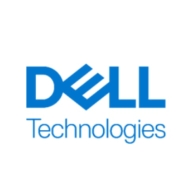


HPE 3PAR StoreServ and Dell PowerStore are two competing storage solutions. Users are generally happier with the pricing and support of HPE 3PAR StoreServ, though Dell PowerStore is favored for its feature set, making it worth its higher price.
Features: HPE 3PAR StoreServ is valued for its reliability, performance, and scalability. Dell PowerStore is praised for its advanced technology, data reduction capabilities, and ease of integration.
Room For Improvement: HPE 3PAR StoreServ users mention the need for improved firmware updates, reporting tools, and better software compatibility. Dell PowerStore users seek enhancements in its monitoring features, better documentation, and improved user interface.
Ease Of Deployment and Customer Service: HPE 3PAR StoreServ is applauded for its straightforward deployment and reliable customer service. Dell PowerStore receives mixed reviews for its deployment process but is recognized for solid customer support.
Pricing and ROI: HPE 3PAR StoreServ is viewed as cost-effective with a better short-term ROI. Dell PowerStore has a higher initial setup cost but delivers a long-term ROI that justifies the investment due to its advanced capabilities.
If you wait more than seven years to buy another one, you get a return on your investment.
If you purchase storage with 300 terabytes, you can easily achieve one petabyte of effective capacity.
It's been trouble-free the entire time, with very high performance, as it has been designed and built properly.
We have seen a return on our investment in Dell PowerStore; definitely our cost per terabyte has been very good compared to some of the other vendors that we would have been using previously, and our performance benchmarks have exceeded what we were expecting.
The return on investment is very good.
Customers always have their issues resolved promptly.
Technical support is good at least through vendors, not directly with the principal.
I would rate the technical support of Dell PowerStore between nine and ten out of ten.
They're responsive, knowledgeable, and have a quick turnaround.
On a scale of one to ten, I would rate Dell support as a ten, focusing on that aspect alone, because it's what allows me to sleep at night.
If we activate the 3PAR call home function, then the remote technician always has access to our StoreServ and provides strong suggestions to improve our 3PAR performance.
It hasn't broken down anytime in the last six to seven years, despite hurricanes, earthquakes, and power outages.
The solution's scalability is a ten out of ten.
It scales up and scales out both ways, and as our data keeps growing, it is very easy to just keep attaching and keep growing.
Scaling up can be done from a single enclosure that already has two controllers to a maximum of four storage units with up to eight controllers, and a massive amount of storage can be added.
I would rate the stability of the product at seven out of ten.
When I removed all the cables, it failed over within five minutes.
It's quite stable and reliable in general.
There are no bugs or glitches and it doesn't crash or freeze.
HPE 3PAR is a very stable solution from HPE, and people have been using this for more than five years.
My experience with the stability and performance of HPE 3PAR StoreServ involved one crash, which was caused by failing hardware.
One way to improve the product is to add an operational assistant that doesn't depend on VMware.
I would like to see some AI features that would allow arrays to intelligently identify threats or unusual behavior in the data pattern and give an alert.
Storage replication should be essential.
Something needs to be done with the caching to ensure that if some issue occurs, there needs to be an ability to disable caching during maintenance to make it static, safe, and good.
Pricing must also be considered, as Dell PowerStore is quite expensive compared to competitors in the market like HPE Alletra, Huawei Dorado, or Hitachi storage, for example.
The main reason why people move to Pure Storage is because it's simplified.
In Pakistan, some parts are not readily available, and we need to import them from Singapore or other countries.
HPE 3PAR StoreServ might be missing certain features available in newer products.
While the prices may be higher than those of other vendors, we see it as a market leader with benefits.
The support can be a bit pricey, but the solution is more cost-effective than anything else out there.
Likely the cost is $400,000 whereas IBM may be $250,000.
Based on my experience, the cost of Dell PowerStore for around 500 GB of capacity is very competitive compared to any other platform in the market.
I asked for a new quotation on a server, and it is quite expensive; it is really expensive.
It is expensive, however, when we compare it to the features provided by HPE, the price-to-performance ratio is very good.
Its data compression feature is the best that we have ever seen.
Pure FlashArray X NVMe helps to improve our processing speed.
We are satisfied with the performance as it is significantly faster compared to traditional storage options.
This includes storage sharing, adding servers to the service, and the wireless host connection on the network side.
Dell PowerStore offers good integration capabilities, especially since it helps with backup, which is an important aspect.
In terms of whether my company could reduce the power consumption with Dell PowerStore, I would say that my company had a use case with a customer around three weeks ago where their old Dell EMC VNX Storage System used to draw about 2500 watts compared to Dell PowerStore which drew about 800 watts, which is a really a big saving looking at the twenty-four hours and seven days of usage of the system.
There is no downtime when we upgrade our 3PAR systems.
I find the HPE 3PAR StoreServ valuable for its ease of use and resilience, which is beneficial.
| Product | Market Share (%) |
|---|---|
| Dell PowerStore | 14.7% |
| HPE 3PAR StoreServ | 3.1% |
| Pure FlashArray X NVMe | 1.4% |
| Other | 80.8% |


| Company Size | Count |
|---|---|
| Small Business | 15 |
| Midsize Enterprise | 11 |
| Large Enterprise | 12 |
| Company Size | Count |
|---|---|
| Small Business | 51 |
| Midsize Enterprise | 34 |
| Large Enterprise | 77 |
| Company Size | Count |
|---|---|
| Small Business | 72 |
| Midsize Enterprise | 74 |
| Large Enterprise | 170 |
Pure Storage FlashArray//X is the world’s first enterprise-class, all-NVMe flash storage array. It represents a new class of storage – shared accelerated storage, which is a term coined by Gartner – that delivers major breakthroughs in performance, simplicity, and consolidation.
Dell PowerStore is a scalable, high-performance platform supporting both modern and traditional workloads, enhancing IT operations with AI-driven automation and advanced data reduction features.
Designed for flexibility, Dell PowerStore integrates seamlessly with VMware, providing robust security and high IOPS. Users benefit from fast NVMe storage, intelligent data management, and scalable performance to handle diverse workload demands. However, improvements are needed in replication, enterprise functionalities, and UI complexity. Stability and support issues highlight the need for enhanced monitoring and pricing strategies.
What are the key features of Dell PowerStore?
What benefits does Dell PowerStore offer?
In industries like finance, healthcare, and IT, Dell PowerStore is critical for VMware virtualization, high-performance databases, and backup storage. It supports hosting virtual machines, mirroring storage, and handling SAP and Oracle databases effectively. Its role in hybrid and on-premises setups showcases its adaptability and integration capabilities for mission-critical tasks.
HPE 3PAR StoreServ is an AI-driven storage solution that prevents issues before they occur by learning and adjusting in real time. The solution offers a tier-1 all-flash foundation for mission-critical workloads. HPE 3PAR StoreServ was designed with more than 3M IOPS and consistent sub-ms latency. It aims to transform midrange and enterprise deployments with solutions that scale from a few TBs to more than 20PBs. In addition, the solution is built to modernize data centers and is made to handle unpredictable workloads effortlessly. By implementing HPE 3PAR StoreServ, you gain automated and rapid provisioning, hardware-accelerated deduplication and compression, and a multi-tenant design.
HPE 3PAR StoreServ Features
HPE 3PAR StoreServ has many valuable key features. Some of the most useful ones include:
HPE 3PAR StoreServ Benefits
There are many benefits to implementing HPE 3PAR StoreServ. Some of the biggest advantages the solution offers include:
Reviews from Real Users
Below are some reviews and helpful feedback written by PeerSpot users currently using the HPE 3PAR StoreServ solution.
A SAN Consultant at a tech services company says, “One of the features that I like the most is the data replication element. The reason I like it is due to the fact that it's pretty clean on replicating data over to a second site. The product stands on its own in heavy enterprise environments. It's easy to make changes without affecting the environment. The solution is very easy to use. The product is very robust and offers very good performance.”
A Storage Manager at a financial services firm mentions, "There are a lot of screens for easy management where you can change some settings. But after a few years, the important settings were better after an upgrade, and all the vendors have other ways to upgrade their systems."
A Senior IT Infrastructure & Data Center Operation Engineer at Ministry of Communications and Information Technology (MCIT) comments, “The adaptive optimization is the biggest feature in 3PAR. 3PAR is very usable with thin volume because it detects zeros while writing. Every time I tell the hypervisor to make the full provisioning, it makes the volume as simple provisioning in 3PAR, not full provisioning.”
We monitor all All-Flash Storage reviews to prevent fraudulent reviews and keep review quality high. We do not post reviews by company employees or direct competitors. We validate each review for authenticity via cross-reference with LinkedIn, and personal follow-up with the reviewer when necessary.